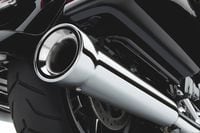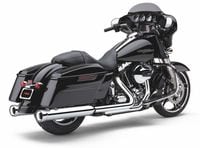Harley-Davidson is getting tagged for $15 million for selling what amounts to emissions-defeat devices will, I predict, be just the start of a broad crackdown on aftermarket modifications to street-legal motorcycles. Harley is, of course, the big target, a large, wealthy manufacturer with the greatest market share. It's also well known among enthusiasts that the old V-twin designs have struggled to make power [and] meet emissions regulations, so one of the first things many buyers did, often before even taking delivery of a new bike, was to jettison the old exhaust, install freer-flowing intake, and hit the fuel injection with a "tuner" module so the bike ran correctly.
California has a head start on this with Senate Bill 435, also known as the Motorcycle Anti-Tampering Act. The law says that motorcycles whose exhaust systems do not display approved EPA approval stickers or stampings can earn their owners a fine and a "fix-it" ticket. It's $50-$100 for the first offense, $100-$250 for subsequent offenses. The owner will also receive a fix it ticket that, upon proving the change was made, will allow the courts to dismiss the monetary penalty. What's interesting about the way the law is written is that the excessive noise is not considered probable cause to be pulled over. "A violation of this section shall be considered a mechanical violation and a peace officer shall not stop a motorcycle solely on a suspicion of a violation of this section. A peace officer shall cite a violation of this section as a secondary infraction." The law applies to new motorcycles manufactured on or after January 1, 2013.
In the aftermath of this bill’s passing, many aftermarket companies simply stopped selling exhaust system into California, while others went the difficult and costly route of getting approval for their systems. And yet the sale and installation of “non approved” exhaust systems, all labeled for “off-road” or “competition use” only, continued in the Golden State.
California’s S.B. 435 was based on the simple act of tampering—it did not specify a new set of noise limits—and any widespread prohibitions on devices that change fuel injection and/or ignition settings from stock will likely be based on the same idea. The manufacturer has tested and certified that its models meet state and federal emissions regulation in place at the time of manufacture, but all that goes out the window when you slap on an aftermarket tuner. There’s no telling of your special tune makes your bike exceed emissions limits until it’s tested, but the assumption from lawmakers is that it [could] and that’s unacceptable. To them.
Where the train left the rails, as far as the EPA is concerned, is the part where dealers were happy to install or recommend these tuning modules for “competition use only” on bikes that will never turn a wheel in anger. Unless you race your Softail regularly. This disregard for the law was so flagrant even non-motorcyclists could tell something wasn’t right; a touring rig with mom-and-pop seats, gleaming saddlebags, and 40K on the odo isn’t a competition machine. Period.
For decades, the outlaw image of motorcycling reflected in the gleam of short, straight pipes and reverberated off the walls. It was part of the culture, largely tolerate. Society has becoming increasingly short-fused with the prototypical biker, ripping down Main Street on his loud-as-hell machine. In Sturgis or Daytona, it’s part of the circus. But for many, channeling an angry Clint Eastwood’s “get off my lawn” scowl, the noise and the casual disregard has simply gone too far.
If you want to blame-storm a little more, you can mention Volkswagen. The public outcry after it was revealed the company used emissions-defeat software to get some of its diesels to pass was much louder and more vociferous than I’d expected. And you know there are ongoing investigations at virtually every automaker, and it’s just a matter of time before someone else is caught shading the rules. It’s obvious that the general public has little tolerance for “cheaters” and where there’s voter animus you can count on there being political pressure to “do something.”
We’ve long had the ability to make motorcycles run better than when they were delivered, ranging from home-made changes to fully engineered exhaust, from jet kits to incredibly sophisticated aftermarket “bolt on” solutions or all-out reprogramming of the injection/ignition/ride-by-wire computer. Some of these make the bike illegal in terms of emissions. The days of defending the changes by saying your license-plate-wearing commuter-mobile is, really, just a track bike and is never ridden on the street [wink, wink], are absolutely numbered.












/cloudfront-us-east-1.images.arcpublishing.com/octane/VZZXJQ6U3FESFPZCBVXKFSUG4A.jpg)
/cloudfront-us-east-1.images.arcpublishing.com/octane/QCZEPHQAMRHZPLHTDJBIJVWL3M.jpg)
/cloudfront-us-east-1.images.arcpublishing.com/octane/HXOUJXQWA5HBHGRO3EMJIGFMVI.jpg)

/cloudfront-us-east-1.images.arcpublishing.com/octane/3TIWWRV4JBBOLDVGRYECVVTA7Y.jpg)
/cloudfront-us-east-1.images.arcpublishing.com/octane/KIX5O23D5NAIBGFXBN3327DKZU.jpg)
/cloudfront-us-east-1.images.arcpublishing.com/octane/7GJYDUIPXRGMTMQKN6ONYOLBOU.jpg)
/cloudfront-us-east-1.images.arcpublishing.com/octane/MUQLOVLL2ZDGFH25ILABNBXKTI.jpg)
/cloudfront-us-east-1.images.arcpublishing.com/octane/TNOU5DNE2BC57MFPMGN2EIDXAM.jpg)
/cloudfront-us-east-1.images.arcpublishing.com/octane/GTCXACQGJ5HAPDTGWUQKDEH44E.jpg)
/cloudfront-us-east-1.images.arcpublishing.com/octane/S35YGSEMEZB4BLTDJTSZPF4GLA.jpg)
/cloudfront-us-east-1.images.arcpublishing.com/octane/5UOT6HPX2JFMRJAX6EH45AR4MQ.jpg)
/cloudfront-us-east-1.images.arcpublishing.com/octane/OKWOJWAKP5EP3OACCRRWPCIX2Q.jpg)
/cloudfront-us-east-1.images.arcpublishing.com/octane/2WF3SCE3NFBQXLDNJM7KMXA45E.jpg)
/cloudfront-us-east-1.images.arcpublishing.com/octane/G4MG6OUCJNBSHIS2MVVOTPX65E.jpg)
/cloudfront-us-east-1.images.arcpublishing.com/octane/IIGGWFOTOJGB7DB6DGBXCCMTDY.jpg)
/cloudfront-us-east-1.images.arcpublishing.com/octane/QSTCM6AVEZA5JJBUXNIQ3DSOF4.jpg)
/cloudfront-us-east-1.images.arcpublishing.com/octane/U4I7G625B5DMLF2DVIJDFZVV6M.jpg)
/cloudfront-us-east-1.images.arcpublishing.com/octane/B6XD6LS6IVCQPIU6HXDJSM3FHY.jpg)
/cloudfront-us-east-1.images.arcpublishing.com/octane/ICL63FEDDRDTTMINYICCEYGMDA.jpg)
/cloudfront-us-east-1.images.arcpublishing.com/octane/FCGZHQXRBZFLBAPC5SDIQLVF4I.jpg)
/cloudfront-us-east-1.images.arcpublishing.com/octane/WNOB6LDOIFFHJKPSVIWDYUGOPM.jpg)

/cloudfront-us-east-1.images.arcpublishing.com/octane/X33NU3E525ECRHXLNUJN2FTRKI.jpg)